MARKET OVERVIEW
The Global Infusion Pump Software market is a niche domain in the field of medical technology. The Infusion Pump Software mainly deals with the development of advanced software solutions for integration in infusion pumps to deliver the right and efficient administration of medication. The central purpose of infusion pump software is to increase the accuracy and safety of medications delivered to patients, ultimately eliminating human error and improving patient outcomes.
The need for intelligent software in infusion pumps is significantly growing with the further development of healthcare systems all over the world. It serves to control complex requirements in support of intravenously delivered drugs to ensure that the right amount at the correct time gets to the patient. With advancing prevalence in chronic diseases and an increasing need for effective management of long-term treatments, a rise in demand for these systems likely lies in the future.
The integration of infusion pump software has some benefits, such as automation that drastically reduces manual inputs by health professionals. It also lessens errors, which are very critical in a medical environment. Additionally, it allows for monitoring the actions of people in real-time and the response of the data in terms of treatment effectiveness. Such information can be used to make informed decisions on the plan of treatment and, where necessary, to make improvements on it for better care of the patient.
Global Infusion Pump Software Market will be natured with high-end technology solutions. The infusion pump software will adopt artificial intelligence, machine learning, and predictive analytics to provide promoters of care with a personalized treatment approach, making medical treatments agile, proactive, and patient-centric.
Another advantage is that it is able to integrate with the EHR system. This will enable all the information about patients to be current and easily available, thus integrating better coordination among health professionals. In the near future, this could be one of the basic features of infusion pump software—that is, integration with EHR systems—thus further aiding healthcare processes for better patient outcomes.
Regulatory aspects are another important part of the market for global infusion pump software. Such systems need to follow very tight healthcare legislation and regulation in order to be guaranteed safe and effective. Companies will thus have to circumnavigate these regulations as the market expands by calibrating their products according to a dynamic array of health authorities' standards.
The competitive landscape of the Global Infusion Pump Software market includes established medical device manufacturers and newly innovative software companies. In these issues, such entities will have to collaborate in order to come up with newer solutions. Strategic partnerships and mergers are surely bound to happen more in the near future when companies will turn to each other's strengths and expand presence in the market.
Global Infusion Pump Software turns out to be an active and crucial part of medical technology. Advanced software integrated with infusion pumps delivers diverse advantages in the form of accuracy, automated processes, real-time monitoring, and better care. With technological advancement forming the future of healthcare, it will lead to increased demand from sophisticated infusion pump software that drives both innovation and patient outcomes. Regulatory compliance, technological integration, and strategic collaborations are other pointers likely to influence growth, making the market an area of continued critical focus among stakeholders in the healthcare sector.
Global Infusion Pump Software market is estimated to reach $728.9 Million by 2031; growing at a CAGR of 7.6% from 2024 to 2031.
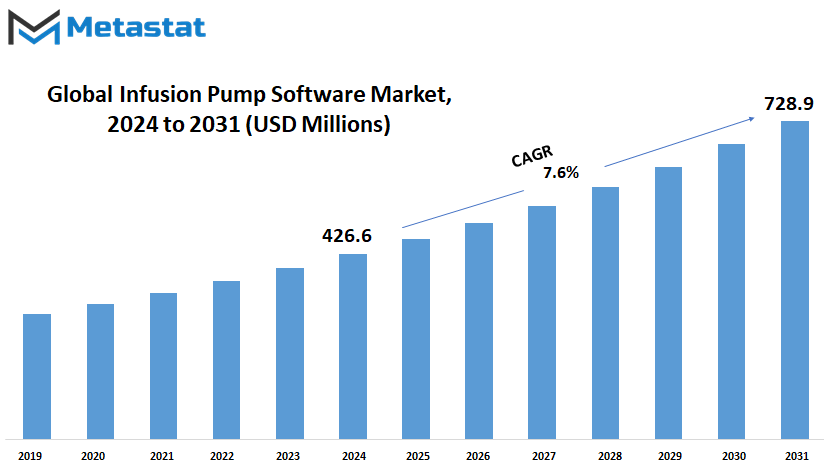
GROWTH FACTORS
Future prospects for the Global Infusion Pump Software market are best judged to be promising because of some growth drivers such as a rise in chronic diseases and related demand for advanced health care solutions, which include infusion pump software. These software systems increase the efficiency and safety of infusion pumps; hence they have become quite vital in modern medical treatments. In the medium term, infusion pump software is likely to see broad acceptance, which again can foster further growth with the rising momentum of technological advancement.
One of the biggest reasons for this market will be technological development related to medical devices. This development has increased the functionality and reliability of infusion pumps to large extents. Otherwise stated, the medication infusion process could not deliver accurate dosage of medication to the patient without these. The advanced pumps, by virtue of their increased accuracy and safety features, reduce the chances of errors and thus help in giving better care. Mentioned below is how the developed credibility of technology is likely to one day encourage the broader adoption of pumps within healthcare facilities.
However, there exist some factors that can act as barriers to the growth of this market. The advanced infusion pump systems and their associated software are very costly for small health centers, which creates a barrier to access and to the implementation of these advanced systems at less privileged medical centers. Another challenge is the potential cybersecurity threats to the infusion pump software and malfunctioning of the software. That said, security and reliability are prime factors for these systems; a failure can lead to devastating consequences in terms of patient safety.
However, there are strong growth opportunities in this market, with one of the major developments being more affordable and user-friendly infusion pump software. This will make such systems more accessible to a lot more healthcare providers, especially the smaller ones like clinics and hospitals. Other areas that could use some fine-tuning are the security features against cyber risks, which keep off many from using the technology. On the basis of such improvements, the market can easily scale present barriers and go on to register substantial growth in the near future.
The Global Infusion Pump Software market will be continued to grow, particularly by the rise in demand for better healthcare solutions and technological advances in medical devices. Despite the uphill task of expensive software and threats from cyber-attacks, opportunities that arise with more pocket-friendly, more secure, and easier-to-use software are much greater. With such stepping-up developments, the infusion pump software market will see much expanded use and high growth, ultimately contributing to the benefit of patient care and outcome.
MARKET SEGMENTATION
By Application
The Global Infusion Pump Software market is on course to record massive developments considering the varied applications lined across the spectrum. Exponentially growing healthcare technology, demand for advanced infusion pump software grows variously in several medical fields. The market, in this section, is split into General Infusion, Pain and Anesthesia Management, Insulin Infusion, Enteral Infusion, Chemotherapy, Pediatrics/Neonatology, Hematology, Gastroenterology, and other niche domains.
In the near future, General Infusion will experience software advancements that improve accuracy and efficiency. The smarter infusion pumps will make the management of patients more intuitive, reducing the margin for error. Pain and Anesthesia Management software will be integrated to other hospital systems that will work together for optimal pain relief with minimal side effects for optimal outcomes in patients. Improvements like this will help in the acute and chronic management of pain by the provision of real-time data to healthcare providers.
This implies that the development of Insulin Infusion software is likely to become more prevalent as diabetes burdens increase all over the world. Innovations will enhance both the UI and connectivity in insulin pumps and will make them more accessible and user-friendly. That would enable better management of the condition by the patients themselves, thus hence not putting more pressure on healthcare systems. Enteral infusion software—the programs ensuring that correct and safe nutrient delivery for administration to patients who cannot take it orally due to their higher risk of aspiration shall equally be developed.
Chemotherapy infusion software will continue to evolve in terms of better customization and monitoring capabilities, enabling oncologists to better personalize treatment plans and optimize patient outcomes while minimizing adverse effects. In Pediatrics/Neonatology, there will be an increased call for specialized infusion software attending to the peculiar needs of infants and children. This segment will see even more precise and safe infusion protocols.
Other two areas to show growth regarding the infusion pump software market will be in hematology and gastroenterology applications. In the case of hematology, the software will be much more organized with regards to blood-related disorders and will have options for integration with diagnostic tools. Advanced software to support the supply of medicines and food to patients that suffer from digestive disorders will be introduced in the area of gastroenterology.
Other specialized areas in the Global Infusion Pump Software market will also witness this trend. Artificial intelligence and machine learning will make more or less decisive contributions to these developments, enabling predictive analytics to provide customized treatment plans. That is what it will mean for the future of how infusion therapy is administered: more efficient, precise, and oriented to the patient.
These diverse infusion pump software applications will also continue fueling the global infusion pump software market with this growth factor. Improvements in health technologies will, therefore, remain of benefit to not only the patients themselves but also healthcare operations at large in making infusion therapy both safer and effective for a wide array of indications. It shall set a big stake in the future of healthcare as the market evolves, developing state-of-the-art solutions to satisfy the growing demands made by patients and healthcare providers alike.
By Infusion Method
The global infusion pump software market is expected to undergo significant changes in the upcoming years. Infusion pumps, critical in delivering fluids—among them medicinal and nutritional—into a patient's body in amounts that have a controlled rate, are reaching a higher level of dependence on advanced software to improve upon their precision and safety. Integration of sophisticated software in infusion pumps will play a key role in improving the quality of care, reducing medication errors, as well as increasing the efficiency of delivering healthcare.
Market segmentation includes infusion methods: Intravenous, Arterial, Subcutaneous, and Epidural. All methods of infusion have their own advantages and are chosen on the basis of a patient's medical condition. Of these, the intravenous infusion segment is likely to retain its lead in the market since this channel of administration is used in hospitals with a range of medications. Software for intravenous pumps is only expected to get easier to use, making it easier for healthcare professionals to deliver treatments with more precision and safety.
Arterial infusion, though less used, will also realize some improvements. This type of infusion, mainly adopted for the administration of drugs into arteries, is very important in some clinical cases, like chemotherapy and handling vascular diseases. Software used on these pumps will probably be improved to allow more advanced real-time monitoring of changes and adjustments so as to make the infusion process more precise, hence ensuring perfect results on the patients.
The subcutaneous infusion, that is, the fluids being delivered under the skin, is becoming increasingly used in home healthcare and long-term treatments. On the other hand, subcutaneous infusion pumps software is definitely going to be inclined toward remote monitoring and telemedicine applications for the patients, continuing the care outside the conventional settings. This will improve the quality of life for the patient and reduce the burden on healthcare facilities.
Epidural infusion, mainly for labor and surgical pain management, would certainly undergo improvement with software that brought enhanced control over the rate of delivery of drugs and improved monitoring facilities for patients. This would make the protocol of pain management very effective and ensure that the dosage administered to the patient is optimal, producing minimal side effects.
The future of the Global Infusion Pump Software market is very promising, and by continuous innovations, improving function and reliability is sure for an infusion pump. Therefore, we can expect greater impacts on better health outcomes and more efficient healthcare services that would come in the near future as healthcare systems around the world adopt these advanced technologies. Cutting-edge software integrated into infusion pumps will thus aid in the easy and hassle-free performance of medical procedures, probably opening up more personalized and responsive treatment options through continuous evolution in the medical technologies that revolutionize the way healthcare delivery is perceived.
By End User
In the future, the Global Infusion Pump Software market is going to rule healthcare. The remarkable surge it will undergo shall be fueled by the substantial demand prompted by the needs of drug infusion accuracy and the concern for patient safety. The infusion of software in infusion pumps is going to change the way medical professionals administer drugs—by ensuring dosage accuracy while avoiding human error.
It will still be the case that hospitals and clinics use the biggest proportion of infusion pump software. Advanced software integrated into these institutions will improve workflow, patient outcome, and compliance with strict regulatory standards. The future will see hospitals going for more sophisticated systems that allow real-time monitoring and adjustments, hence an aspect of more personalized patient care. Such settings will increasingly be host to data analytics and artificial intelligence, which will permit healthcare providers to track performance metrics and thereby make better-informed decisions, helping to augment the quality of care.
Home healthcare is another such segment where the infusion pump software market will make a telling contribution. With the increasing trend of patients going for home-based treatments, the need for reliable, user-friendly infusion pump software is on the rise. Future developments in software will make the treatments user-friendly, thus patients and carers can operate them with little professional input. Many of these systems allow for remote monitoring of the patient's progress and permit intervention where necessary by the treatment provider. This would enhance not only patient convenience but also reduce healthcare costs by way of fewer visits to hospitals.
Advancements in infusion pump software will also enrich ambulatory and surgical centers. These centers will make use of software to make the management of patients easier, which enables the delivery of treatments on time and with accuracy. Sharing information accurately will be a big part of care coordination in the future, where infusion pump software will be connected to electronic health records. Integration into an electronic health record will be vital in surgical care settings where timely medication delivery matters the most.
Other end users, including research institutions and pharmaceutical companies, will also use infusion pump software to improve their operations. At research institutions, the software will enable very fine control required for drug delivery during clinical trials for better reliability and reproducibility in results. Infusion pump software running at pharmaceutical companies will help develop and test new systems of drug delivery, really pushing the edge of medical science.
The overall growth of the Global Infusion Pump Software market will be high, driven by the need for technologically advanced and efficient healthcare solutions. Its future lies in greater adoption of smart technologies, improvement in patient outcomes, and enhancement of operational efficiency across different healthcare settings. The infusion pump software is bound to take a lead role in driving innovation into healthcare with solutions that will help meet the peculiar needs of patients and health providers across the world if it is to remain relevant.
|
Report Coverage |
Details |
|
Forecast Period |
2024-2031 |
|
Market Size in 2024 |
$426.6 Million |
|
Market Size by 2031 |
$728.9 Million |
|
Growth Rate from 2024 to 2031 |
7.6%. |
|
Base Year |
2022 |
|
Regions Covered |
North America, Europe, Asia-Pacific Green, South America, Middle East & Africa |
REGIONAL ANALYSIS
The regional diversity of the global infusion pump software market shows that various e-health advancements and adoptions take place all over the world. North America that includes the U.S., Canada, and Mexico, is foreseen to maintain a leading stance on account of advanced healthcare infrastructure with substantial investments in medical technology. Markets in countries like the U.S. will drive particularly, with the increasing incidence of chronic diseases and rapidly surging implementation of new medical software.
Significant growth in the market will be evident in Europe: the UK, Germany, France, and Italy. These countries are trying to modernize healthcare facilities, and implementation of advanced infusion pump software in the health-cares will modernize patient care. Supportive government policies and the adoption of leading medical device manufacturer products in these regions will boost the adoption rate. The remaining Europe also contributes to the growth in the market, However, it may be a little slow due to differences in the level of development in healthcare
Asia Pacific is an emerging market for the infusion pump software market, which is poised for significant growth rate. Other developing nations that offer gigantic potential include India, China, Japan, and South Korea, which are investing heavily in health sector infrastructure and technological development. Again, China with its huge population, and its increasing expenditure towards healthcare, will play a major role. Japan and South Korea, equipped with technological advancements, will also see huge growth. India's market will be driven by its expanding middle class and increasing demand for quality healthcare services. The rest of Asia Pacific follows as regional economies advance.
Countries in South America, especially those with boosted economies – Brazil and Argentina – will witness sturdy growth for the infusion pump software market. Healthier healthcare infrastructure and growing awareness regarding advanced medical technologies are the drivers in this region. Large market size in Brazil for healthcare will act as a regional driver, and Argentina should contribute towards growing investments in healthcare. Rest of South America should also experience slow rise in the rate of adoption, fusing pump software gain recognition for benefits.
As compared to other regions; growth in Middle East & Africa will be mixed. GCC countries such as Saudi Arabia, UAE, and Qatar are bound to take the largest share of the market in the region, also having injected massive investments in the integration of modern healthcare technologies. The other two countries poised for impressive growth are Egypt and South Africa, which are both investment destinations and countries with improving healthcare and a growing shift to advanced medical solutions. The remainder of the Middle East & Africa will catch up over time toward infusion pump software courtesy of international help and regional healthcare projects.
The future for the global infusion pump software market will be one rooted very much in continued technological advancement and increased healthcare demand in these various regions. With each region advancing into the market, the total market will see expansion, which in turn will lead to increased patient care and smoother medical operations around the world.
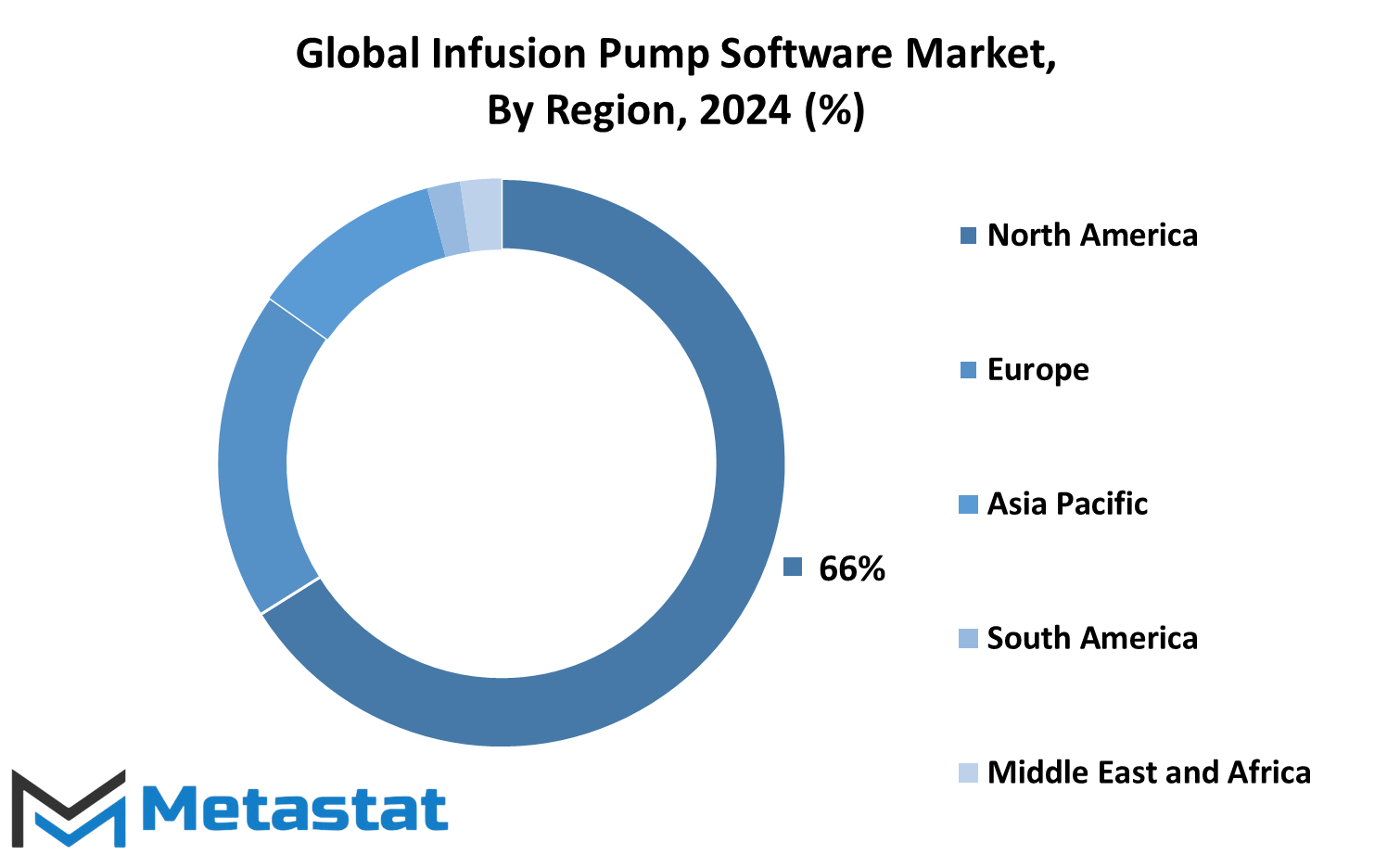
COMPETITIVE PLAYERS
The Global Infusion Pump Software can be expected to grow tremendously in the coming years. Devices for delivering medicine and other nutrients into the body of patients, infusion pumps are now being infused with sophisticated software that results in truly advanced medical devices able to offer greater precision and reliability in their functionality, thus ensuring better health for their patients. With so many key players in this market category, each spawns changes in both technology and patient care.
The major players for the segment include BD, ICU Medical, B. Braun, and Moog. All of these companies have an upgrading spree for infusion pump software in terms of safety features and user-friendly interface, with the integration of the same into electronic health records. Other major players are Baxter and Medtronic, both of which bring a long history of medical experience to the table while developing software that extends the abilities and capabilities for infusion pumps.
Fresenius Kabi and Terumo Medical have committed themselves to qualitative management and precision. Their software solutions will help minimize errors and ensure correct dosing. Ypsomed and Smiths Medical correspond to the innovation commitment in infusion technology with reliable and intuitive software.
Agilent Technologies and Merck KGaA have also made great strides in the infusion pump software market; these companies are very well recognized for their contribution to other areas in healthcare. Their ability to adapt to the changing needs of healthcare providers with experience in Medical technology helped in coming up with innovative Software Solutions. Other key players are Q Core Medical Ltd. and Roche Diagnostics, both bringing other experiences and technologies to the table.
In the future, the Global Infusion Pump Software industry will further integrate artificial intelligence and machine learning. The very same technologies are attempting to make the Infusion pumps capable enough to predict any issue and in real-time change the parameters to propagate better the safety and efficacy of the treatment. Cloud-based platforms for remote monitoring and management for these infusion pumps will be developed to grant more flexibility and control to healthcare professionals.
Second, the demand for infusion pump software will be driven by the increasing focus on personalized medicine that can tailor treatments to suit individual patients. This would require sophisticated algorithms and data analytics capabilities, into which MS enterprises have already been pouring a great deal of investment.
All in all, competition currently characterizes the Global Infusion Pump Software market. Key players in this segment continue to push boundaries, and their innovative perspectives on technological growth are likely to prove very instrumental in the future of healthcare. These firms are going to help create infusion pumps that are not only more efficient but also safer and more adaptable to the requirements of patients across the globe.
Infusion Pump Software Market Key Segments:
By Application
- General Infusion
- Pain And Anesthesia Management
- Insulin Infusion
- Enteral Infusion
- Chemotherapy
- Pediatrics/Neonatology
- Hematology
- Gastroenterology
- Others
By Infusion Method
- Intravenous
- Arterial
- Subcutaneous
- Epidural
By End User
- Hospitals And Clinics
- Home Healthcare
- Ambulatory And Surgical Centers
- Others
Key Global Infusion Pump Software Industry Players
- BD
- ICU Medical
- B. Braun
- Moog
- Baxter
- Medtronic
- Fresenius Kabi
- Terumo Medical
- Ypsomed
- Smiths Medical
- Agilent Technologies
- Merck KGaA
- Q Core Medical Ltd
- Roche Diagnostics
WHAT REPORT PROVIDES
- Full in-depth analysis of the parent Industry
- Important changes in market and its dynamics
- Segmentation details of the market
- Former, on-going, and projected market analysis in terms of volume and value
- Assessment of niche industry developments
- Market share analysis
- Key strategies of major players
- Emerging segments and regional growth potential



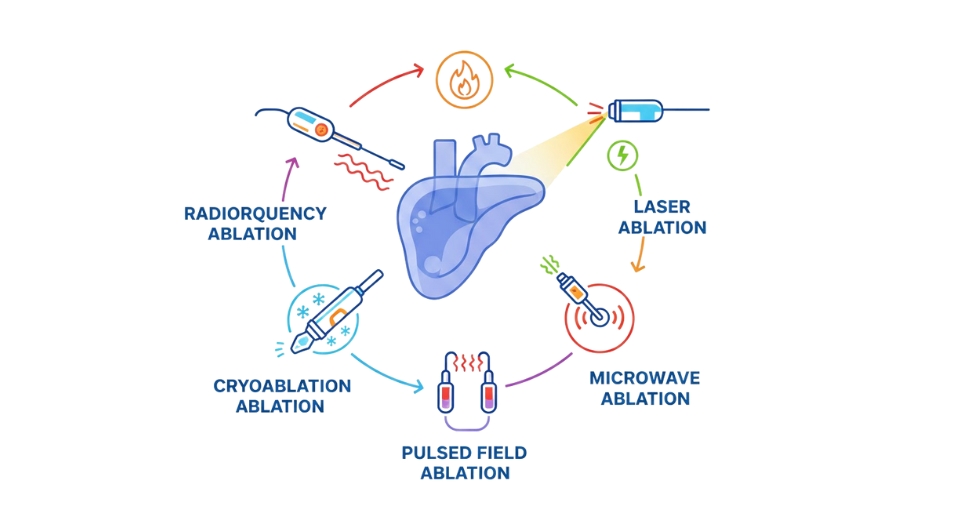

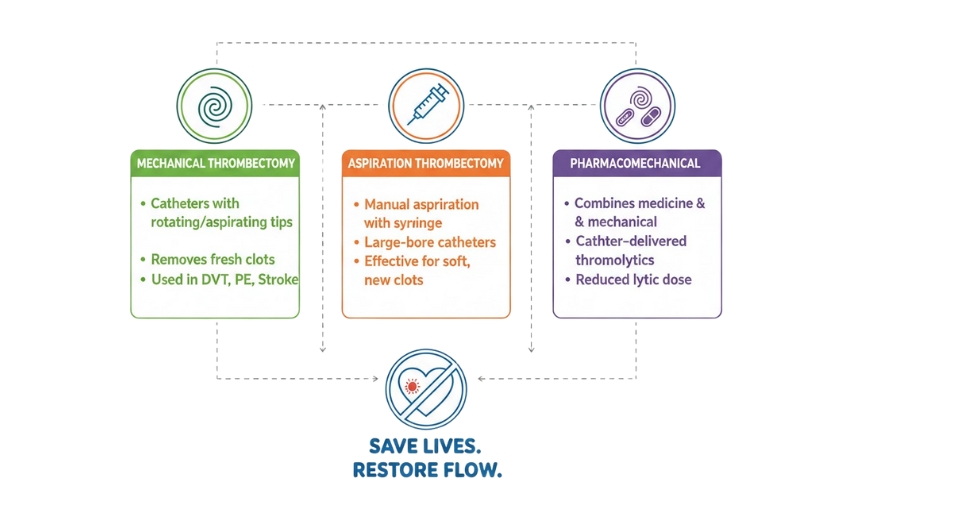
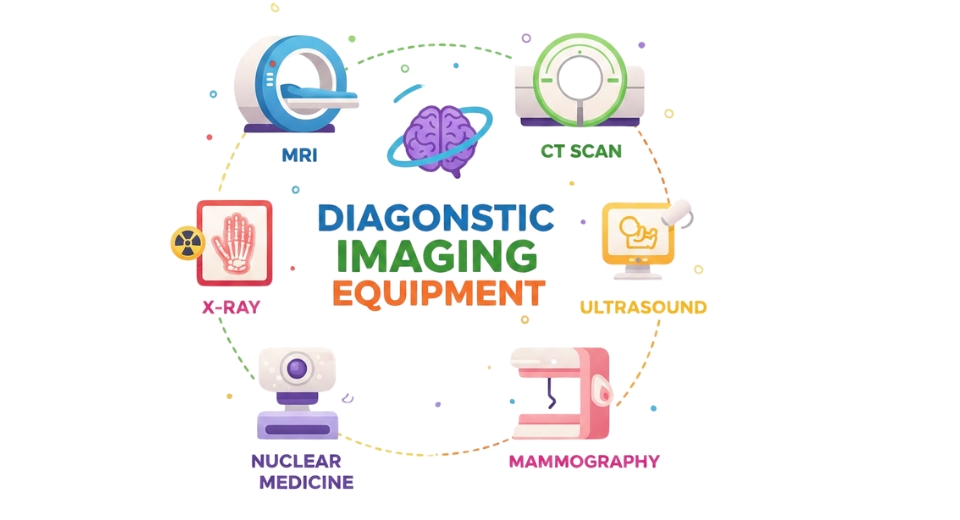

 US: +1 3023308252
US: +1 3023308252






